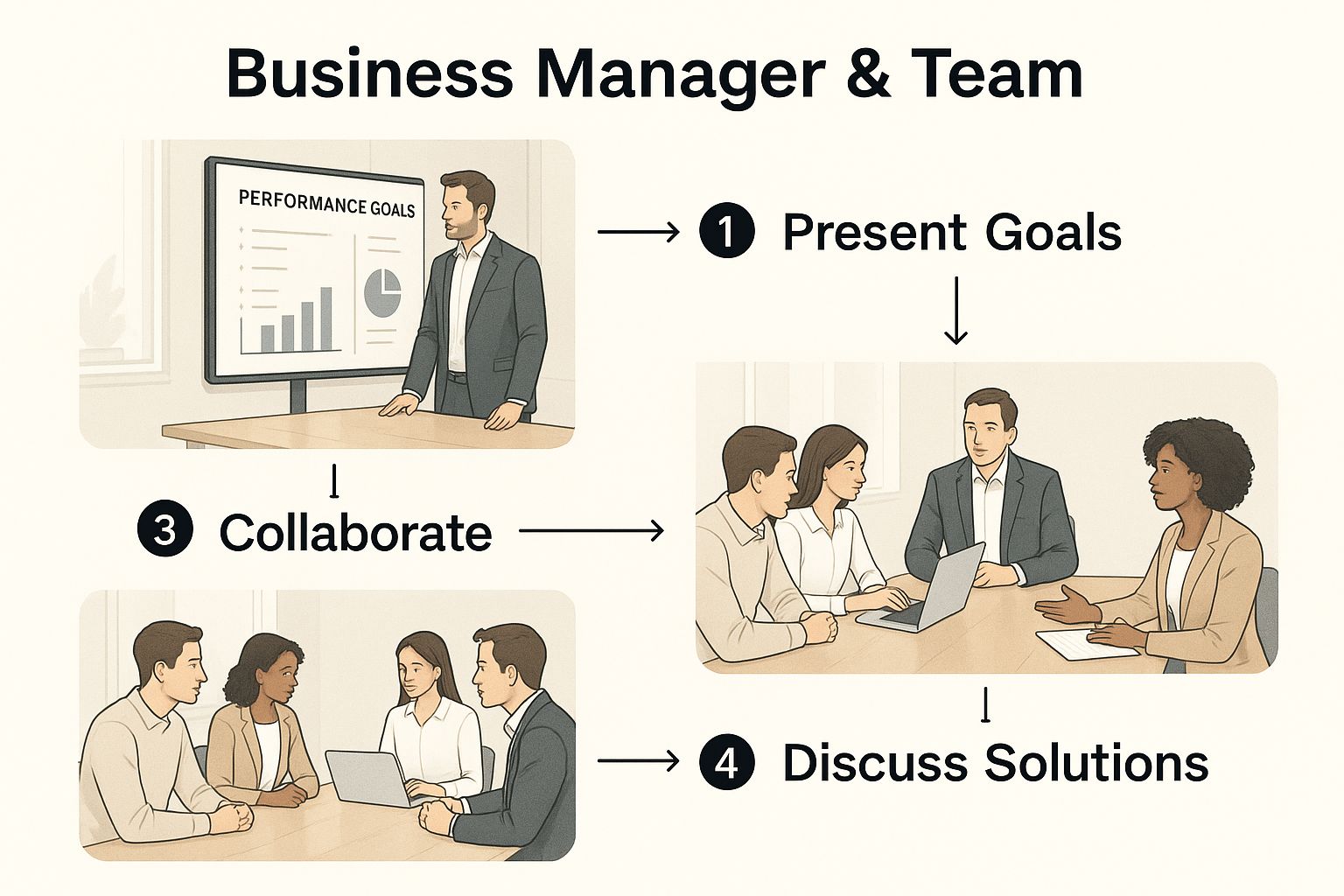A Guide to the Performance Management Cycle
Discover how a modern performance management cycle can transform your team's output. A practical guide to goal setting, feedback, and growth.
The performance management cycle isn't just another piece of HR jargon. It’s a framework for turning the dreaded annual review into an ongoing, productive conversation. It’s a continuous loop where managers and employees actually work together to plan, track, and talk about an employee’s goals and how their work fits into the bigger company picture.
This is a huge shift away from the old, dusty model of a once-a-year judgment day.
Breaking Down the Performance Management Cycle
Think about training for a marathon. You wouldn't just show up on race day and hope for the best, right? Of course not. You’d have a structured plan: a training schedule, regular check-ins on your pace, and adjustments along the way. Building a high-performing team works the exact same way.
The performance management cycle breaks that "training" down into a simple, repeatable loop. It’s a system designed to build momentum and keep everyone aligned, turning performance management from a yearly event into a constant dialogue about growth.
A Journey, Not a Destination
A modern performance management cycle is proactive. It’s not a reactive report card filled with surprises. The whole idea is that consistent coaching and clear, shared goals are far more powerful than a single, high-stakes assessment at the end of the year.
This is what it looks like in practice—a collaborative effort, not a top-down directive.

As you can see, it’s all about transparency and shared ownership. Goals are out in the open, and progress is tracked together. Each phase flows logically into the next, creating a system that fuels real, sustainable growth.
The Four Core Phases
The entire journey breaks down into four simple, repeating steps. Each one is essential for keeping the momentum going.
- Planning: This is where you set the destination. It’s a collaborative session where managers and employees agree on clear, measurable goals that actually connect to what the company is trying to achieve.
- Monitoring: This is the day-to-day grind of tracking progress. It happens through regular, informal check-ins and continuous feedback, allowing for quick adjustments before things go off the rails.
- Reviewing: At key moments, managers and employees sit down for a more formal conversation. They talk about progress, celebrate wins, and pinpoint specific areas for development and growth.
- Rewarding: The final piece of the puzzle. This step is about recognizing and rewarding the hard work and contributions, which reinforces great performance and motivates the team for the next cycle.
Yet, this is where most companies stumble. Gallup research found that a shocking only 2% of CHROs believe their current systems actually inspire improvement. That’s a massive disconnect.
The goal isn't just to measure performance—it's to improve it. An effective cycle is a development tool that builds communication, clarifies what's expected, and gives employees a clear path to get better at their jobs.
To make sure your cycle actually drives results, you need a solid foundation. Implementing Performance Management Best Practices is a great place to start. This cyclical approach helps create a culture where feedback flows freely, goals are crystal clear, and everyone on the team understands exactly how their work pushes the entire company forward.
Planning Goals for Maximum Team Impact
The entire performance management cycle kicks off with a clear destination. Without one, teams are just busy, not productive. This first phase—planning—is where you and your team collaboratively define what success actually looks like, making sure every single person's effort pushes the company in the same direction. This isn't about handing down a list of tasks; it’s about forging a shared mission.
When goals feel disconnected from the bigger picture, motivation tanks. A study from Betterworks revealed that a staggering 21% of employees have annual goals that are never looked at again after being set. It's the classic "set it and forget it" trap, and it breeds disengagement while wasting energy on work that doesn't move the needle.

Beyond SMART Goals to OKRs
While SMART (Specific, Measurable, Achievable, Relevant, Time-bound) goals give you a solid foundation, modern frameworks like OKRs (Objectives and Key Results) take things a step further. OKRs are designed to draw a direct line from an individual's daily work right up to the company's biggest ambitions.
- Objective: This is the big, ambitious, "what if" goal. It answers the question, "Where do we want to go?" An objective should be inspiring and feel just a little bit out of reach. For example, "Become the go-to resource for early-stage founders."
- Key Results: These are the measurable outcomes that prove you're on your way. They answer, "How will we know we’re getting there?" Key results are numbers-driven and specific, like "Increase organic sign-ups by 40%" or "Publish 12 in-depth founder guides."
This structure doesn't just assign work; it gives every person a clear sense of purpose by connecting their individual contributions directly to team and company wins. This is how you build a truly aligned team.
True alignment isn’t about everyone doing the same thing. It’s about everyone’s different contributions adding up to the same outcome. The planning phase is where you draw that map.
A Founder's Checklist for Goal Setting
Great goal-setting is a conversation, not a directive. It’s a joint effort where managers and employees define success together. This collaborative back-and-forth is what creates genuine ownership right from the start. If you want to go deeper on this, our guide on how to set goals effectively has even more detailed strategies.
To make sure these conversations are truly productive, here’s a simple checklist every founder and team lead should run through:
- Start with the 'Why': Does the employee really get how this goal plugs into the company's bigger quarterly or annual objectives?
- Define 'Done' Clearly: Have you agreed on specific, measurable key results? Is there any ambiguity about what success looks like?
- Identify Potential Roadblocks: What might get in the way? What resources or support will they need from you or others to knock this out of the park?
- Establish Check-in Rhythms: How will you both track progress? Agree on a cadence for quick check-ins to review what’s working and offer support.
- Confirm Mutual Commitment: End the conversation by asking, "Do you feel confident and committed to making this happen?"
When you kick off the performance cycle with this level of clarity and collaboration, you're not just setting goals. You're setting the stage for a period of focused work, deep engagement, and results that actually matter.
Monitoring Progress Without Micromanaging
Okay, the goals are set. Now the performance management cycle moves into its most active—and most delicate—phase. This is where plans collide with reality.
Monitoring progress is all about staying informed and supportive. The real goal here is to create a culture of coaching and course-correction, not surveillance. It’s about maintaining visibility without making your team feel like they’re stuck under a microscope.
Effective monitoring lives and dies on psychological safety. When your team feels comfortable sharing roadblocks without fearing blame, you get unfiltered, ground-level intelligence in real time. That trust is what lets you spot a small snag before it explodes into a major setback.
Shifting from Reactive to Proactive
Here’s a classic mistake: focusing only on what’s already happened. If you truly want to guide performance, you have to understand the difference between two kinds of metrics.
- Lagging Indicators: These are the results you look at in the rearview mirror—things like quarterly sales figures or project completion rates. They tell you what happened, but by the time you see them, it's too late to change the outcome.
- Leading Indicators: These are the actions that predict future success. Think about the number of sales demos done this week or the percentage of code passing quality checks on the first try. They’re forward-looking, giving you a chance to make adjustments before the quarter ends.
By focusing more on leading indicators, managers stop being scorekeepers and start being proactive coaches. You’re guiding the actions that actually produce the results you want. This is the secret to effectively measuring productivity at work without getting bogged down by vanity metrics.
Creating a System for Continuous Insight
Even with the best cycle, most teams struggle to know whether they’re actually making consistent progress. The problem is a lack of visibility. Recent surveys show that a staggering 61% of managers don't have a clear view into their team's performance, making it nearly impossible to spot skill gaps or even recognize great work. You can dig into more of these performance management trends at PeopleStrong.com.
SprintDojo solves this by combining daily progress tracking, weekly team reviews, and AI-powered forecasting into one alignment system. It attacks the visibility gap where so many managers struggle, helping remote and startup teams forecast goals and track progress without adding more meetings.
Research shows small wins are the #1 motivator for sustained team performance (Amabile & Kramer, 2011), and SprintDojo builds this into your team’s daily rhythm.
This approach transforms monitoring from a manager's chore into a shared, transparent process. Instead of asking, "What did you do yesterday?" the system answers, "Where are we heading this week?" It empowers teams with the data they need to self-correct, fostering a culture of ownership and genuine accountability. The focus shifts from tracking busywork to understanding real momentum—which is the beating heart of a successful performance management cycle.
Conducting Meaningful Performance Reviews
Let's be honest: the phrase "performance review" usually makes people cringe. It brings up images of a stiff, one-sided meeting where a manager reads from a checklist. But it doesn't have to be that way.
A modern review flips that script entirely. It's not a backward-looking judgment; it's a forward-looking conversation. Think of it as a collaborative pit stop to look at the map, celebrate how far you’ve come, and chart the best course for the road ahead. It's a dialogue, not a monologue.
The secret to a great review? Data, not memory. When you pull from the notes and observations gathered during the continuous monitoring phase, the conversation is grounded in reality. No recency bias, no vague feelings—just tangible outcomes and specific examples.
Structuring a Two-Way Conversation
A productive review is built on shared ownership. It’s a space where the employee is an active participant in evaluating their own performance, not just a passive recipient of feedback.
To make these conversations genuinely motivating, you need a framework. For a deep dive, you can explore our detailed guide on performance review best practices.
But here’s a simple structure to get you started:
- Start with Self-Reflection: Ask the employee to come prepared. They should have their own assessment of their wins, roadblocks, and where they want to grow next.
- Celebrate the Wins: Always kick things off by acknowledging specific contributions and successes. This creates psychological safety and opens the door for a more constructive chat about development.
- Discuss Development Opportunities: Frame challenges as growth opportunities, not failures. Work together to pinpoint the skills or behaviors to focus on in the next cycle.
The most meaningful reviews happen when a manager asks more questions than they answer. The goal is to unlock the employee's perspective on their own performance and potential.
Broadening Perspectives with 360-Degree Feedback
A manager's view is crucial, but it’s only one piece of the puzzle. An employee’s real impact is felt across the entire team, in ways a manager might never see.
This is where 360-degree feedback comes in. It’s a process of gathering confidential, constructive input from peers, direct reports, and even people they work with in other departments. This holistic approach paints a much richer picture of an individual's performance, highlighting strengths and blind spots that might otherwise go unnoticed.
When it’s collected and shared the right way, peer feedback helps people understand their real impact on others. It builds a culture where everyone feels accountable for supporting each other's growth.
The table below breaks down why this shift away from the dreaded annual event is so critical.
Traditional Annual Review vs Modern Continuous Review
| Aspect | Traditional Annual Review | Modern Continuous Review |
|---|---|---|
| Frequency | Once a year | Ongoing (weekly, bi-weekly, or monthly check-ins) |
| Focus | Backward-looking, judgmental | Forward-looking, developmental |
| Data Source | Manager's memory, recency bias | Real-time data, notes, and specific examples |
| Ownership | Manager-led monologue | Collaborative dialogue, employee-driven |
| Outcome | Surprises, anxiety, defensiveness | Alignment, clarity, motivation, no surprises |
Ultimately, the goal is to make the formal review a summary of conversations that have been happening all along. By discussing progress frequently, employees can adjust their goals and behaviors when it matters most—not months after the fact. When the review finally happens, there are no surprises, only a shared understanding and a clear path forward.
Rewarding and Recognizing Team Contributions
This is where the rubber meets the road. The final phase of the performance management cycle isn't just about closing out the quarter; it's about proving the whole system means something. Rewarding and recognizing contributions is more than just an annual bonus—it’s the consistent acknowledgment that turns good performance into a self-sustaining culture.
When people see a straight, transparent line connecting their effort to a meaningful reward, motivation doesn't just spike. It compounds.
This is your chance to show that the company actually values results and appreciates hard work. If you drop the ball here, all the progress from planning, monitoring, and reviewing evaporates. You send a crystal-clear message that going the extra mile goes unnoticed, which is a one-way ticket to disengagement.
More Than Money: How to Build a Culture of Appreciation
Especially for startups and smaller businesses, a powerful rewards system doesn't have to break the bank. In fact, study after study shows that non-financial rewards can be just as potent—if not more so—in building long-term motivation. The secret is making recognition timely, specific, and genuine.
You need to think beyond the paycheck. Consider these high-impact, low-cost moves:
- Public Recognition: Never underestimate the power of a sincere "thank you" in a team meeting or a shout-out in a company-wide channel. It validates a person's work in front of their peers, and that’s huge.
- Skill Development Opportunities: Offering to pay for a course, a conference ticket, or a certification does more than just upskill your team. It shows you're invested in their career, not just their immediate output.
- Increased Autonomy and Ownership: Trust is one of the biggest rewards you can give. Handing a high-performer more control over their projects or the freedom to spearhead a new initiative shows deep respect for their judgment.
The most effective recognition is immediate. When you link a reward directly to a specific achievement, you're reinforcing the exact behavior you want to see more of. It leverages the power of "small wins" to keep momentum sky-high.
Making the System Fair and Transparent
For any of this to work, your rewards system has to be seen as fair. Ambiguity is the enemy—it breeds resentment and absolutely tanks morale. The entire point of the performance cycle is to create a clear, data-informed picture of who did what, and that picture must be the foundation for your rewards.
It’s simple, really: link rewards directly back to the goals and outcomes you all agreed on in the planning phase.
When someone not only hits but crushes their key results, the reward shouldn't feel like a surprise gift. It should feel like a natural, predictable outcome. That kind of transparency vaporizes subjectivity and builds real trust in leadership, turning the whole cycle into a true engine for growth.
Common Questions About Performance Management
Even with a solid grasp of the four phases, putting a performance management cycle into practice always brings up a few “what ifs” and “how tos.” Let’s tackle the most common questions founders and managers ask.
How Often Should We Really Be Doing This?
The simple answer? Continuously. But let’s get real. While the monitoring phase should feel like a daily or weekly habit built around check-ins, the formal planning and reviewing phases need a more structured cadence.
At a minimum, aim for quarterly. This rhythm is agile enough to keep goals from getting stale but structured enough to provide a clear benchmark. The goal is to ditch the dusty, once-a-year performance review and embrace a rhythm that actually matches the speed of your business.
What's the Single Biggest Mistake We Can Make?
Treating it like a bureaucratic HR task that happens once a year. That’s the kill shot. An effective performance cycle is a living, breathing leadership tool—not a “check-the-box” exercise filled with paperwork and surprise ratings.
When performance management becomes about an annual confrontation instead of a continuous conversation, it loses all its power. Worse, it actively demotivates your team. The whole point is dialogue and development, not judgment.
Will This Actually Work for a Small Startup or a Remote Team?
Absolutely. In fact, it's even more critical in those environments. For startups and remote teams, alignment isn't just a nice-to-have; it's a survival mechanism.
The core principles don’t change: set clear goals, track progress where everyone can see it, have regular feedback chats, and celebrate great work.
For remote teams especially, using a lightweight tool can be a game-changer. It creates the visibility and connection you lose without physical proximity. Instead of becoming a logistical headache, the cycle strengthens communication and ensures everyone is on the same page, rowing in the same direction—which is everything when you’re a small, distributed team focused on growth.
Sprint Smarter. Forecast Every Week.
Log wins. Build momentum. Let AI show you if you're on track to hit your sprint goal—before it's too late.
Join the waitlist and be the first to unlock predictive clarity for your team.

